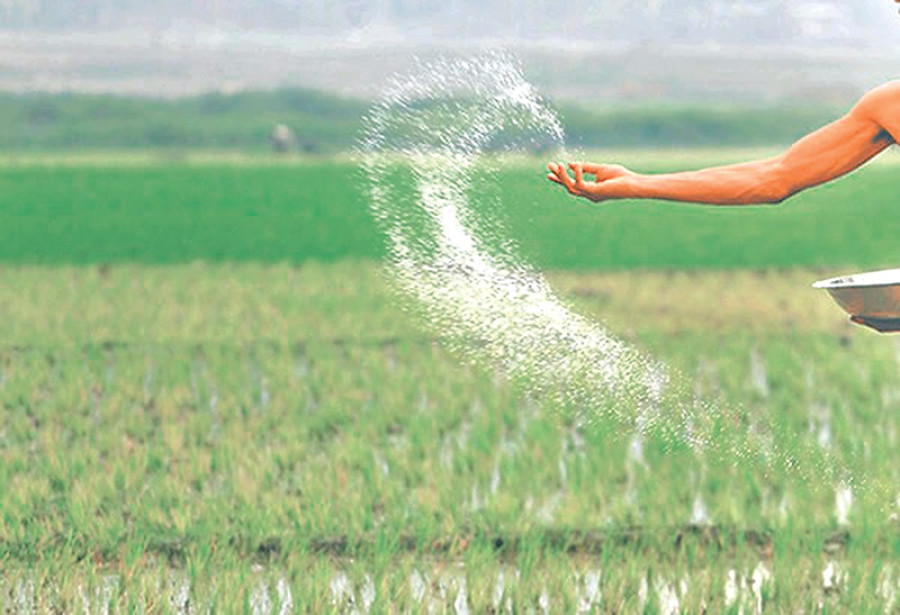Opinion
Who is going to farm?
A few days ago, I had a chance to talk to the secretary of the Ministry of Agriculture and Development (MoAD) about food security issues in Nepal.
Jagannath Adhikari
A few days ago, I had a chance to talk to the secretary of the Ministry of Agriculture and Development (MoAD) about food security issues in Nepal. Before elaborating on core matters, he narrated the situation of his own land in Gorkha, which has remained fallow due to a shortage of people who are willing to cultivate his farm—a farm which fed him and supported his education. “My family cultivated each and every inch of the farm and produced grain to the land’s maximum capacity; we sold some grain to finance my study,” he said. The secretary was looking to sell the land so that a new owner could cultivate it, but he did not find any buyers. My own story is similar to his. Now, it has become the story of many families.
The MoAD has estimated that about 27 percent of the cultivated land in the country is now fallow. This trend is even more evident in the hills and mountains. In the past year, a few journal editors sent me research articles written on this topic for review. These articles clearly show that the scale of land lying fallow is much larger than what the secretary explained. For example, a study conducted in Lamjung revealed that as much as 50 percent of the land now lies fallow. I also talked to the researchers conducting this study. Using places like Duradanda in Lamjung as an example, they told me that good paddy-producing terraced-lands are now completely fallow. These were the same terraces developed by the hard work of earlier generations which helped feed the people who lived there and enriched their cultural life.
Lack of incentives
People are not willing to work the land they own mainly because there is a shortage of labourers to assist, the wage rates are high, and farming is relatively less profitable than non-farm employment in cities or in foreign lands. Currently, people are farmers mainly out of compulsion; they do not get any other work and so they have no other option. Now these farmers also need to buy expensive farm-inputs like chemical fertilisers, pesticides, new seeds and so on. The necessity to purchase these inputs is also partly due to the shortage of family labour to make manure at home by raising livestock or composting. In rural areas, it is said that those families that have no family labour cannot afford to cultivate the land. And in more and more rural families, only the elderly stay at home while their children migrate.
Young people certainly have an incentive to migrate. The main attraction lies in the chance to earn higher incomes. It is understandable that they are willing to take the risks involved. A recent study conducted by Nepal Rastra Bank in 16 districts revealed that the average annual income of a youth within Nepal was Rs 90,521, and that of a youth working in foreign country, as reported by his/her family members, was Rs532,000. This shows that the annual income of someone working overseas was more than five times that of someone working in Nepal. If this is the ground reality, who would not go to foreign countries if they get the opportunity?
Growing imports
The shortage of labour is affecting other development projects, too. For example, it is reported that there is a shortage of about 50,000 labourers for reconstruction of houses in earthquake-affected districts. There is a shortage of skilled labourers despite the high wage rate they command.
Given this state of rural farm production, it is no wonder that Nepal’s import of food grains has skyrocketed. Nepal imports agro products worth about Rs140billion a year now; six years ago, the figure was Rs44billion. Such rapid rise in food import and growing dependence on other countries for food is now a major national challenge. The increase in food prices is also a concern from a food security perspective.
The rural landscape has also changed due to previously cultivated land now lying fallow and a depopulation of rural areas. It is well known that people in earlier generations maintained and cultivated land, built irrigation channels and houses and made rural areas lively through their socio-cultural activities. Many of these activities were integrated with farming processes. Because the land is now fallow, there has been a great loss; a diverse set of traditionally grown plants is no longer grown and animals no longer raised. This has led to an erosion of agro-civilisation—an intangible loss which could have severe impacts on our food culture that was suitable for a given socio-economic and environmental context. The food culture established due to imported foodstuffs could further deteriorate food security and the general health of the population. We have begun to see its adverse impacts in the form of, for example, obesity in children.
Against this background, several questions come to mind regarding what could be done to encourage the youth to farm their land and produce more food. Or, is such encouragement unnecessary, as people could begin to cultivate the land once again whenever required? After all, as stated by the secretary of the MoAD, many of the policies they adopted to improve the situation have not worked well. At one time, the MoAD considered fining people who keep their land fallow; however, as even small farmers have not cultivated their land and instead retained it for future use and security, that policy would have harmed them. Of course, once the farming culture is abandoned for a long time, it might not be possible to restart it. This has become a serious policy issue to ponder.
Adhikari is a human geographer with an interest in development planning




 12.12°C Kathmandu
12.12°C Kathmandu










%20(1).jpg&w=300&height=200)

